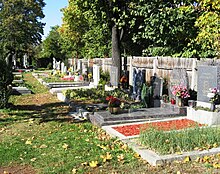Stadlau cemetery
The Stadlauer Friedhof is a cemetery in the Stadlau part of Vienna's 22nd district, Donaustadt . The main entrance is at Gemeindeaugasse 27.
history
Originally the residents of what was then the Viennese suburb of Stadlau had their dead buried in the cemetery around the church of St. Georg in Kagran . When this was abandoned and the municipality of Kagran built a new local cemetery in 1875, Stadlau followed this example that same year. The Stadlauer Friedhof was built “in a south-easterly direction from Stadlau on the Au Hutweide place” at the end of the former Klostergasse and was connected to the village by an avenue . It was consecrated on August 22, 1875 by the Kagran pastor Andreas Huger. A specially delegated priest from the Kagran parish took over the blessings .
The cemetery was expanded for the first time in 1891. In 1898 the community of the “ Sisters of the poor child Jesus ”, which had founded the Maria Frieden monastery in the Stadlauer Au area as early as 1889 , was given a separate section on the cemetery grounds, enclosed by an iron grating, from the Stadlau community . The Order of the Salesians Don Bosco, which has been active in Stadlau since 1919 (establishment of the Stadlau Church of the Heart of Jesus in 1924), acquired some grave sites. In 1915/16, 1925 and 1929 the cemetery was expanded again. In 1930 the funeral hall was built.
From 1876, a cast-iron cross stood in the center of the cemetery grounds, which fell over and broke in 1946 during a severe storm. Since 1947 , the "Homecoming Cross" designed by the sculptor Josef Franz Riedl has been located here (at this time a number of Stadlauers returned from captivity ), which was erected " In memory of all those who died in Stadlau who rest in strange earth ".
A closure of the Stadlauer Friedhof and some other Viennese cemeteries planned by the Vienna City Council was to take place by 1975. After the deadline was extended to 1985, however, this plan was overturned by a referendum in 1980 . Since the existence of the cemetery was now secured, some redesigns were carried out in the 1980s. A new office building was built and the funeral hall was rebuilt. The architect Erich Boltenstern designed the interior of the laying out room. At the western end of the cemetery in Gemeindeaugasse, a new precast wall was built. New gates were created along Hardeggasse, as these became more important as a result of the urban expansion in this area.
General
The Stadlauer Friedhof is administered by the cemetery master Walter Rybak on behalf of Friedhöfe Wien GmbH and, with an area of just under 15,000 m² and around 2,400 grave sites, is one of the rather small cemeteries in Vienna. Famous names can hardly be found on the gravestones , so the cemetery is one of the few in Vienna that does not contain any grave sites dedicated by the City of Vienna . This can be explained on the one hand by the small size of the cemetery, on the other hand by the fact that the former suburb of Stadlau, due to its location across the Danube, was further away from Vienna than the western suburbs, for example. In addition, Stadlau was originally a farming village and in the second half of the 19th century it developed into a railway and industrial site, which is why it was once mainly the local farmers and workers who were buried here.
The above-ground route of the underground line U2, which is run as an elevated railway in the Danube City area, runs directly next to the northern fence of the cemetery, the Hardeggasse station is only a few steps away from the cemetery.
Graves of important personalities
| Surname | Life dates | activity |
|---|---|---|
| Robert Bleichsteiner | 1891-1954 | Ethnologist |
| Josef Smistik | 1905-1985 | Soccer player |
| Ernst Skrička | 1946-2020 | Graphic artist |
See also
literature
- Werner T. Bauer: Wiener Friedhofsführer. Exact description of all burial sites together with a history of the Viennese burial system . Falter Verlag, Vienna 2004, ISBN 3-85439-335-0
Web links
Coordinates: 48 ° 13 ′ 13 ″ N , 16 ° 27 ′ 25 ″ E



